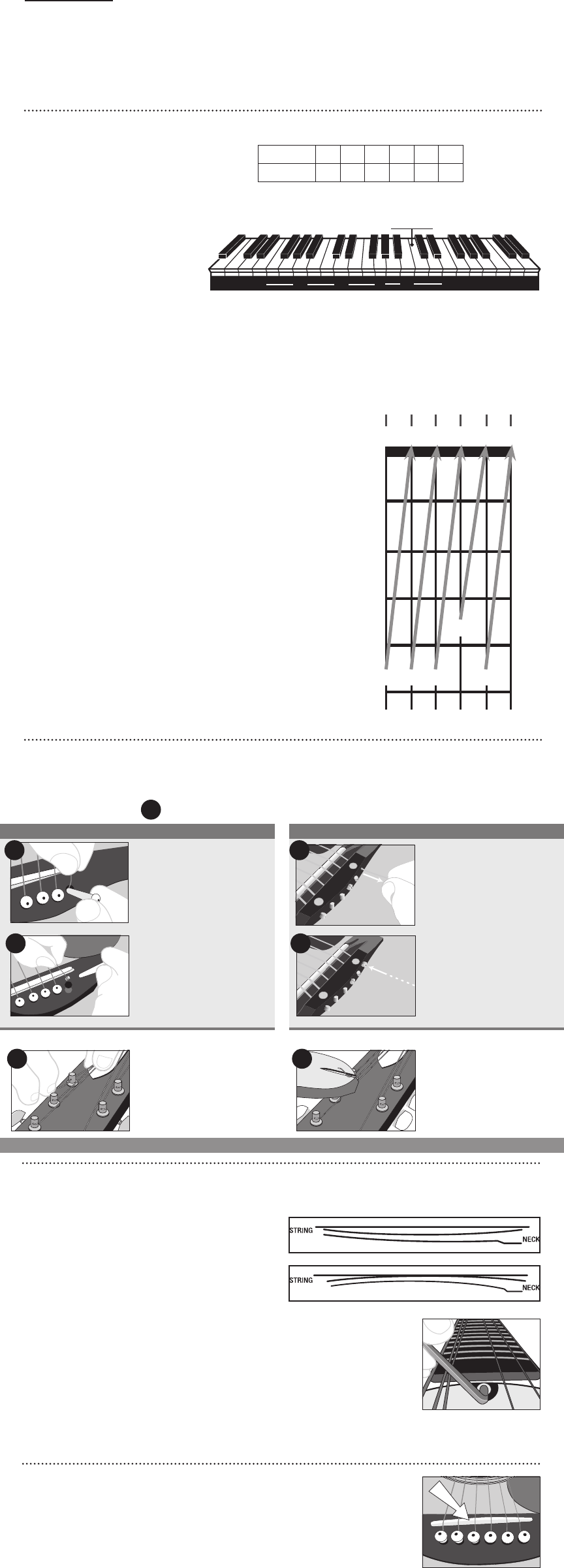
TUNING YOUR GUITAR
Here are three ways to tune a guitar:
1. Tune to another instrument:
For example, you can use a
piano keyboard to tune. Play
the piano keys one at a time,
and tune the corresponding
guitar string to it.
2. Use an electronic tuner
An electronic tuner detects the pitch of each string, and
indicates if the pitch is too high or too low.
STRING 6 5 4 3 2 1
B C D E F G A B C D E F G A B C D E F G A B C D
Middle C
3. Tune the guitar to itself, this is called relative tuning:
E STRING
First, tune the 6th string to an E on a piano or a keyboard,
or any other instrument that is already in tune.
A STRING
Press the 6th string behind the 5th fret and tune the open
5th string to it by turning the 5th tuning key until the two
strings sound the same.
D STRING
Press the 5th string behind the 5th fret and tune the open
4th string to it by turning the 4th tuning key.
G STRING
Press the 4th string behind the 5th fret and tune the open
3rd string to it by turning the 4th tuning key.
B STRING
Press the 3rd string behind the 4th fret and tune the open
2nd string to it by turning the 2nd tuning key.
E STRING
Press the 2nd string behind the 5th fret and tune the open
1st string to it by turning the 1st tuning key.
E A D G B E
6 5 4 3 2 1
A D G E
B
CHANGING STRINGS
Strings should be replaced when they become dirty, discolored, or produce a dull sound. Change one
string at a time to maintain the string tension on the neck. You can change acoustic guitar strings
in five easy steps:
Loosen the string by turning the tuning peg.
Remove the bridge pin.
Pull the ball end of the
string out of the hole, un-
wind the string from the
string post, and remove it
from the guitar
FOR MORE ON TUNING & RESTRINGING, VISIT FIRSTACT.COM
FOR BRIDGES WITH PINS
Feed the end of the string
through the hole in the
tuning peg. Leave some
slack so the string will
wind around the post a
few times.
Bend the end of the
string and tighten it by
turning the tuning peg.
Carefully trim the excess
string with wire cutters.
Stick the ball end of the
new string into the hole.
Push the pin in place and
pull up on the string until
the ball catches under the
bridge. Press down on the
pin until it is secure.
2
3
4
1
FOR BRIDGES WITHOUT PINS
Unwind the string
from the string post
and remove it from
the guitar.
Thread the new string
through the hole in the
hole. Pull the string
through until the ball
catches at the bridge.
2
3
5
This guide shows you how to tune and change the strings on your
guitar. It will also show you how to check your guitar’s action,
and how to make adjustments. These things will help you keep
your guitar in good working order and provide you with years
of enjoyment.
For more on tuning, tips, and tricks visit us online at rstact.com
Happy playing!
TRUSS ROD ADJUSTMENTS
Some guitars have a truss rod. This is a device installed in the neck of the guitar to stabilize and
control the straightness of the neck and to support it against the tension of the strings.
Bow: A neck with a “bow” in the middle will cause
bad action and impair intonation. The truss rod
can be tightened to eliminate a bowed neck.
(To tighten the truss rod, turn clockwise.)
Hump: A neck with a “hump” in the middle will
cause string rattle and false tones. The truss rod
can be loosened to eliminate a hump in the neck.
(To loosen the truss rod, turn counter-clockwise.)
It’s best to have a professional repairperson adjust your guitar’s
truss rod. If you’re doing it yourself, be very careful. Too much of a turn
can damage the neck of your guitar.
If you are familiar with making adjustments yourself, you can
locate the truss rod at the end of the neck, just above the nut of the
guitar. Loosen the 3rd and 4th strings to access the truss rod.
Adjustments should only be made to the truss rod in very small
increments. Start with less than a quarter of a turn. It’s helpful to mark
your truss rod so you can monitor your progress or return it to its
original position.
ADJUSTING THE ACTION
The “action” of a guitar refers to its playability – i.e. the height of the
strings above the frets. On acoustic guitars, the action is determined
by the saddle, which is inserted into the bridge. The saddle can be
lowered by filing it down.
Visit firstact.com for guitar tips and tricks, tuning and stringing
instructions, guitar chord charts, and more!
Standard Tuning:
NOTE E A D G B E
STRING 6 5 4 3 2 1
ACOUSTIC
GUITAR
QUICK START
GUIDE




